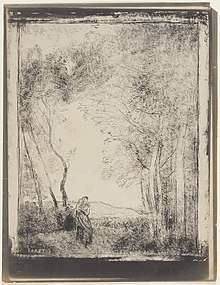Cliché verre
Cliché verre is a combination of painting (and/or drawing) with photography. In brief, it is a method of either etching, painting or drawing on a transparent surface, such as glass, thin paper or film and printing the resulting image on a light sensitive paper in a photographic darkroom. It is a process first practiced by a number of French painters during the early 19th century. The French landscape painter Jean-Baptiste-Camille Corot was the best known of these. Some contemporary artists have developed techniques for achieving a variety of line, tone, texture and color by experimenting with film, frosted Mylar, paint and inks and a wide assortment of tools for painting, etching, scratching, rubbing and daubing. Scratching a negative is another form of cliché verre. Many ways to get different designs for a cliché verre is to print a design off of the computer onto transparent paper. Or even scan a photo onto transparent paper and alter it that way before exposing it.

Cliché verre is French. Cliché is a printing term: a printing plate cast from movable type; while verre means glass.
Cliché verre was one of the earliest forms of reproducing images before the advent of the camera. As a precursor to photography, cliché verre could accurately represent the original scene without the tonal variations available in modern day photography.
External links
| Wikimedia Commons has media related to Cliché-verre. |
- "Cliché-verre", Encyclopedia Britannica
- "Cliche Verre", photography.com
- "Sleight of Camera, Capturing Fleeting Impressions", Karen Rosenberg, 14 March 2008, The New York Times
- "Cliche Verre", silverprint.co.uk via archive.org